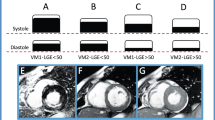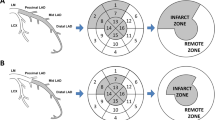Abstract
To evaluate remote myocardial function after ST-elevation myocardial infarction (STEMI) and the impact of infarct size (IS) using cardiovascular magnetic resonance (CMR). 161 patients and 15 controls underwent CMR at 1st week and 6th month after STEMI. Using the 17-segments model, segments were categorized into infarcted, adjacent and remote myocardium. Relative systolic wall thickening (SWT, %) was assessed using the centerline method. IS (% of left ventricular mass) was determined in late enhancement imaging. Overall, in remote myocardium, SWT was comparable (83 ± 32) to controls (77 ± 25, P = .5) and did not increase significantly (P = .2) at the 6th month (88 ± 35, P = .3 vs. control). When IS was categorized into tertiles (<13.6%, (n = 49), 13.7–28.2%, (n = 60), >28.2%, (n = 52)), SWT in the remote area at the 1st week was not different from controls, regardless of infarct size (p between .2 and .8 for all tertiles). At 6 months, SWT was larger compared to controls only in small infarctions (98 ± 34 vs. 77 ± 25, P = .03). In medium and large infarctions there was no difference in SWT of the remote area compared to controls (87 ± 33 and 79 ± 34, P = .3 and P = .09) and there was no significant increase at 6 months (P between .2 and .9). In remote myocardium there was no difference in contractility compared to controls after STEMI. After 6 month a slight hypercontractility can only be observed in small infarctions. In medium and large infarctions no difference of SWT in remote myocardium compared to controls can be observed.




Similar content being viewed by others
References
McKay RG, Pfeffer MA, Pasternak RC, Markis JE, Come PC, Nakao S, Alderman JD, Ferguson JJ, Safian RD, Grossman W (1986) Left ventricular remodeling after myocardial infarction: a corollary to infarct expansion. Circulation 74:693–702
Kramer CM, Lima JA, Reichek N, Ferrari VA, Llaneras MR, Palmon LC, Yeh IT, Tallant B, Axel L (1993) Regional differences in function within noninfarcted myocardium during left ventricular remodeling. Circulation 88:1279–1288
Ito S, Suzuki T, Hosokawa H, Inada T, Takeda Y, Suzumura H, Tomimoto S, Yamada Y, Goto A, Horio T, Suzuki S, Fukutomi T, Itoh M (1999) Increased hyperkinesis in noninfarcted areas during short-term follow-up in patients with first anterior acute myocardial infarction treated by direct percutaneous transluminal coronary angioplasty. Jpn Heart J 40:549–560
Bodi V, Sanchis J, Berenguer A, Insa LD, Chorro FJ, Llacer A, Lopez-Merino V (1999) Wall motion of noninfarcted myocardium. Relationship to regional and global systolic function and to early and late left ventricular dilation. Int J Cardiol 71:157–165
Yang Z, Berr SS, Gilson WD, Toufektsian MC, French BA (2004) Simultaneous evaluation of infarct size and cardiac function in intact mice by contrast-enhanced cardiac magnetic resonance imaging reveals contractile dysfunction in noninfarcted regions early after myocardial infarction. Circulation 109:1161–1167
Kramer CM, Rogers WJ, Theobald TM, Power TP, Geskin G, Reichek N (1997) Dissociation between changes in intramyocardial function and left ventricular volumes in the eight weeks after first anterior myocardial infarction. J Am Coll Cardiol 30:1625–1632
Epstein FH, Yang Z, Gilson WD, Berr SS, Kramer CM, French BA (2002) MR tagging early after myocardial infarction in mice demonstrates contractile dysfunction in adjacent and remote regions. Magn Reson Med 48:399–403
Messroghli DR, Bainbridge GJ, Alfakih K, Jones TR, Plein S, Ridgway JP, Sivananthan MU (2005) Assessment of regional left ventricular function: accuracy and reproducibility of positioning standard short-axis sections in cardiac MR imaging. Radiology 235:229–236
Bodi V, Sanchis J, Lopez-Lereu MP, Losada A, Nunez J, Pellicer M, Bertomeu V, Chorro FJ, Llacer A (2005) Usefulness of a comprehensive cardiovascular magnetic resonance imaging assessment for predicting recovery of left ventricular wall motion in the setting of myocardial stunning. J Am Coll Cardiol 46:1747–1752
Husser O, Bodi V, Sanchis J, Nunez J, Mainar L, Merlos P, Lopez-Lereu MP, Monmeneu JV, Chaustre F, Rumiz E, Riegger GA, Chorro FJ, Llacer A (2010) Head to head comparison of quantitative versus visual analysis of contrast CMR in the setting of myocardial stunning after STEMI: implications on late systolic function and patient outcome. Int J Cardiovasc Imaging 26:559–569
Bodi V, Sanchis J, Lopez-Lereu MP, Nunez J, Mainar L, Monmeneu JV, Husser O, Dominguez E, Chorro FJ, Llacer A (2007) Prognostic value of dipyridamole stress cardiovascular magnetic resonance imaging in patients with known or suspected coronary artery disease. J Am Coll Cardiol 50:1174–1179
Bodi V, Sanchis J, Lopez-Lereu MP, Nunez J, Sanz R, Palau P, Gomez C, Moratal D, Chorro FJ, Llacer A (2006) Microvascular perfusion 1 week and 6 months after myocardial infarction by first-pass perfusion cardiovascular magnetic resonance imaging. Heart 92:1801–1807
Cerqueira MD, Weissman NJ, Dilsizian V, Jacobs AK, Kaul S, Laskey WK, Pennell DJ, Rumberger JA, Ryan T, Verani MS (2002) Standardized myocardial segmentation and nomenclature for tomographic imaging of the heart. A statement for healthcare professionals from the Cardiac Imaging Committee of the Council on Clinical Cardiology of the American Heart Association. Int J Cardiovasc Imaging 18:539–542
Bogaert J, Bosmans H, Maes A, Suetens P, Marchal G, Rademakers FE (2000) Remote myocardial dysfunction after acute anterior myocardial infarction: impact of left ventricular shape on regional function: a magnetic resonance myocardial tagging study. J Am Coll Cardiol 35:1525–1534
Rademakers F, Van de WF, Mortelmans L, Marchal G, Bogaert J (2003) Evolution of regional performance after an acute anterior myocardial infarction in humans using magnetic resonance tagging. J Physiol 546(Pt 3):777–787
Masci PG, Dymarkowski S, Rademakers FE, Bogaert J (2009) Determination of regional ejection fraction in patients with myocardial infarction by using merged late gadolinium enhancement and cine MR: feasibility study. Radiology 250:50–60
Wyatt HL, Forrester JS, da Luz PL, Diamond GA, Chagrasulis R, Swan HJ (1976) Functional abnormalities in nonoccluded regions of myocardium after experimental coronary occlusion. Am J Cardiol 37:366–372
Bodi V, Sanchis J, Lopez-Lereu MP, Nunez J, Mainar L, Pellicer M, Sanz R, Gomez C, Bosch MJ, Husser O, Chorro FJ, Llacer A (2007) Evolution of 5 cardiovascular magnetic resonance-derived viability indexes after reperfused myocardial infarction. Am Heart J 153:649–655
Ripa RS, Nilsson JC, Wang Y, Sondergaard L, Jorgensen E, Kastrup J (2007) Short- and long-term changes in myocardial function, morphology, edema, and infarct mass after ST-segment elevation myocardial infarction evaluated by serial magnetic resonance imaging. Am Heart J 154:929–936
Acknowledgments
This study was supported by the “Instituto de Salud Carlos III” with FIS PI11/02323 and Heracles grants and by the “Fundacion Gent x Gent”.
Conflict of interest
There are no conflict of interest (both personal and institutional) regarding specific financial interests that are relevant to the work conducted or reported in this manuscript.
Author information
Authors and Affiliations
Corresponding author
Rights and permissions
About this article
Cite this article
Husser, O., Chaustre, F., Sanchis, J. et al. Function of remote non-infarcted myocardium after STEMI: analysis with cardiovascular magnetic resonance. Int J Cardiovasc Imaging 28, 2057–2064 (2012). https://doi.org/10.1007/s10554-012-0014-8
Received:
Accepted:
Published:
Issue Date:
DOI: https://doi.org/10.1007/s10554-012-0014-8




